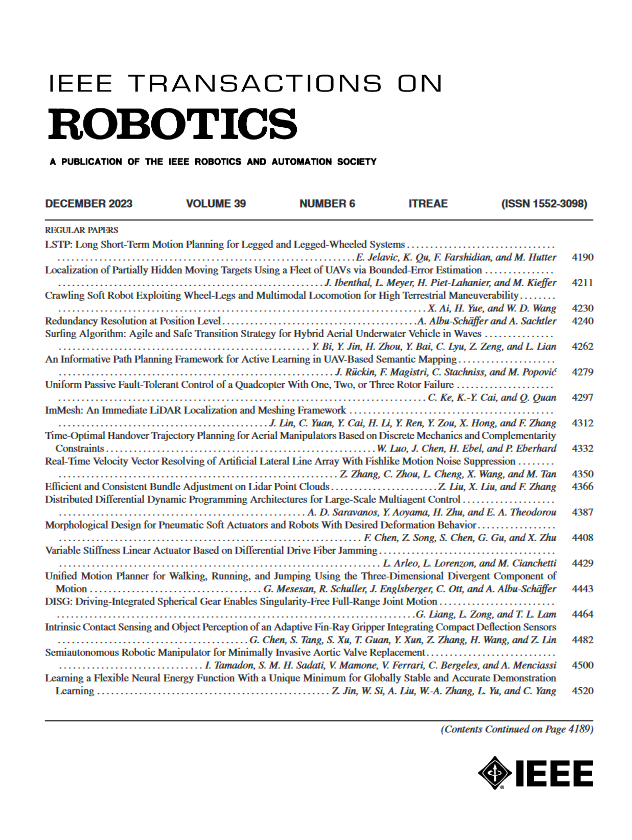LUDO:使用点云占用函数对可变形对象的低延迟理解
IF 10.5
1区 计算机科学
Q1 ROBOTICS
引用次数: 0
摘要
准确确定可变形物体的形状及其内部结构的位置对于需要精确定位的医疗任务至关重要,例如机器人活检。我们介绍了一种精确的低延迟理解可变形物体(LUDO)的方法。LUDO利用占用网络在30毫秒内从单视点云观测中重建变形状态下的物体,包括其内部结构。LUDO为其预测提供不确定性估计。此外,它通过突出其输入观察中的关键特征来提供可解释性。不确定性和可解释性对于手术等安全关键应用都很重要。我们在现实世界的机器人实验中对LUDO进行了评估,在可变形物体内穿刺各种感兴趣区域(roi)的成功率为98.9%。我们将LUDO与流行的基线进行比较,并显示其优越的ROI定位精度、训练时间和内存要求。LUDO展示了与可变形对象交互的潜力,而不需要可变形的注册方法。本文章由计算机程序翻译,如有差异,请以英文原文为准。
LUDO: Low-Latency Understanding of Deformable Objects Using Point Cloud Occupancy Functions
Accurately determining the shape of deformable objects and the location of their internal structures is crucial for medical tasks that require precise targeting, such as robotic biopsies. We introduce a method for accurate low-latency understanding of deformable objects (LUDO). LUDO reconstructs objects in their deformed state, including their internal structures, from a single-view point cloud observation in under 30 ms using occupancy networks. LUDO provides uncertainty estimates for its predictions. In addition, it provides explainability by highlighting key features in its input observations. Both uncertainty and explainability are important for safety-critical applications, such as surgery. We evaluate LUDO in real-world robotic experiments, achieving a success rate of 98.9% for puncturing various regions of interest (ROIs) inside deformable objects. We compare LUDO to a popular baseline and show its superior ROI localization accuracy, training time, and memory requirements. LUDO demonstrates the potential to interact with deformable objects without the need for deformable registration methods.
求助全文
通过发布文献求助,成功后即可免费获取论文全文。
去求助
来源期刊

IEEE Transactions on Robotics
工程技术-机器人学
CiteScore
14.90
自引率
5.10%
发文量
259
审稿时长
6.0 months
期刊介绍:
The IEEE Transactions on Robotics (T-RO) is dedicated to publishing fundamental papers covering all facets of robotics, drawing on interdisciplinary approaches from computer science, control systems, electrical engineering, mathematics, mechanical engineering, and beyond. From industrial applications to service and personal assistants, surgical operations to space, underwater, and remote exploration, robots and intelligent machines play pivotal roles across various domains, including entertainment, safety, search and rescue, military applications, agriculture, and intelligent vehicles.
Special emphasis is placed on intelligent machines and systems designed for unstructured environments, where a significant portion of the environment remains unknown and beyond direct sensing or control.
 求助内容:
求助内容: 应助结果提醒方式:
应助结果提醒方式:


